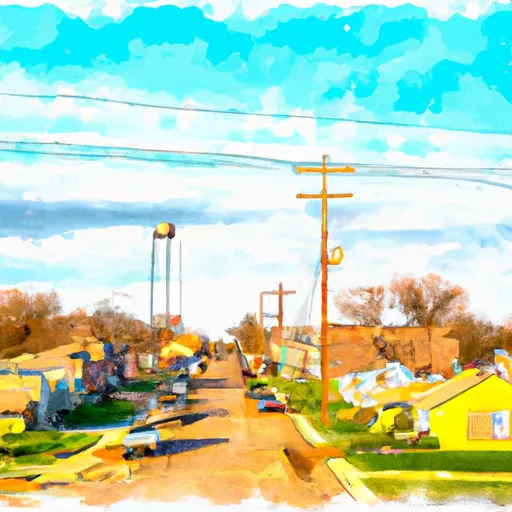-
 Snoflo Premium
Snoflo Premium
Get unlimited access to all our content
With no Ad interruptions! - Start Your Free Trial Login with existing account
Quenemo
Eden Index
Climate
9.7
•
Recreation
4.3
•
Community
0.7
•
Safeguard
5.5/10

Quenemo, Kansas, is a small town located in Osage County. It experiences a humid subtropical climate characterized by hot summers and mild winters. Summers are typically hot with temperatures reaching the high 90s Fahrenheit, while winters are relatively mild, with temperatures averaging in the mid-30s Fahrenheit. The area receives an average annual precipitation of around 40 inches, evenly distributed throughout the year.
Quenemo is situated near the Marais des Cygnes River, which offers hydrology constituents to the area. The river provides opportunities for fishing, boating, and other water-related activities. Its diverse aquatic ecosystem supports a variety of fish species, including catfish, bass, and crappie.
Aside from the river, Quenemo is surrounded by picturesque countryside, making it a great location for outdoor recreation. Hiking trails, camping areas, and wildlife watching are popular activities in the area. Shunga Trail, Lake Pamona, and Pomona State Park are all within driving distance and provide additional opportunities for outdoor enthusiasts.
In summary, Quenemo, Kansas, offers a humid subtropical climate, hydrology constituents from the nearby Marais des Cygnes River, and various outdoor recreation opportunities, making it an appealing destination for nature lovers.
What is the Eden Index?
The Snoflo Eden Index serves as a comprehensive rating system for regions, evaluating their desirability through a holistic assessment of climate health, outdoor recreation opportunities, and natural disaster risk, acknowledging the profound impact of these factors on livability and well-being.
Climate Health Indicator (CHI): 9.7
Quenemo receives approximately
947mm of rain per year,
with humidity levels near 79%
and air temperatures averaging around
13°C.
Quenemo has a plant hardyness factor of
6, meaning
plants and agriculture in this region thrive during a short period during spring and early summer. Most
plants will die off during the colder winter months.
By considering the ideal temperature range, reliable water supplies, clean air, and stable seasonal rain or snowpacks, the Climate Health Indicator (CHI) underscores the significance of a healthy climate as the foundation for quality living.
A healthy climate is paramount for ensuring a high quality of life and livability in a region, fostering both physical well-being and environmental harmony. This can be characterized by ideal temperatures, reliable access to water supplies, clean air, and consistent seasonal rain or snowpacks.
Weather Forecast
Streamflow Conditions
Osage
Area Rivers
Osage
Snowpack Depths
Osage
Reservoir Storage Capacity
Osage
Groundwater Levels
Recreational Opportunity Index (ROI): 4.3
The Recreational Opportunity Index (ROI) recognizes the value of outdoor recreational options, such as parks, hiking trails, camping sites, and fishing spots, while acknowledging that climate plays a pivotal role in ensuring the comfort and consistency of these experiences.
Access to outdoor recreational opportunities, encompassing activities such as parks, hiking, camping, and fishing, is crucial for overall well-being, and the climate plays a pivotal role in enabling and enhancing these experiences, ensuring that individuals can engage in nature-based activities comfortably and consistently.
Camping Areas
| Campground | Campsites | Reservations | Toilets | Showers | Elevation |
|---|---|---|---|---|---|
| Big Creek Ramp - Oologah Lake | None | 653 ft | |||
| Pomona State Park | 370 | 1,023 ft | |||
| Outlet Park - Melvern | None | 979 ft | |||
| Outlet Park - Pomona Reservoir | 35 | 980 ft | |||
| Redmond Cove South - John Redmond Reservoir | None | 1,054 ft | |||
| Arrow Rock - Melvern Reservoir | None | 1,087 ft | |||
| Michigan Valley - Pomona Reservoir | 95 | 998 ft | |||
| Coeur DAlene - Melvern Lake | None | 1,057 ft | |||
| Kelley City Park | None | 1,026 ft | |||
| Eisenhower State Park | 230 | 1,082 ft |
Catastrophe Safeguard Index (CSI):
The Catastrophe Safeguard Index (CSI) recognizes that natural disaster risk, encompassing floods, fires, hurricanes, and tornadoes, can drastically affect safety and the overall appeal of an area.
The level of natural disaster risk in a region significantly affects safety and the overall livability, with climate change amplifying these risks by potentially increasing the frequency and intensity of events like floods, fires, hurricanes, and tornadoes, thereby posing substantial challenges to community resilience and well-being.
Community Resilience Indicator (CRI): 0.7
The Community Resilience Indicator (CRI) recognizes that education, healthcare, and socioeconomics are crucial to the well-being of a region. The CRI acknowledges the profound impact of these elements on residents' overall quality of life. By evaluating educational resources, healthcare accessibility, and economic inclusivity, the index captures the essential aspects that contribute to a thriving community, fostering resident satisfaction, equity, and social cohesion.

